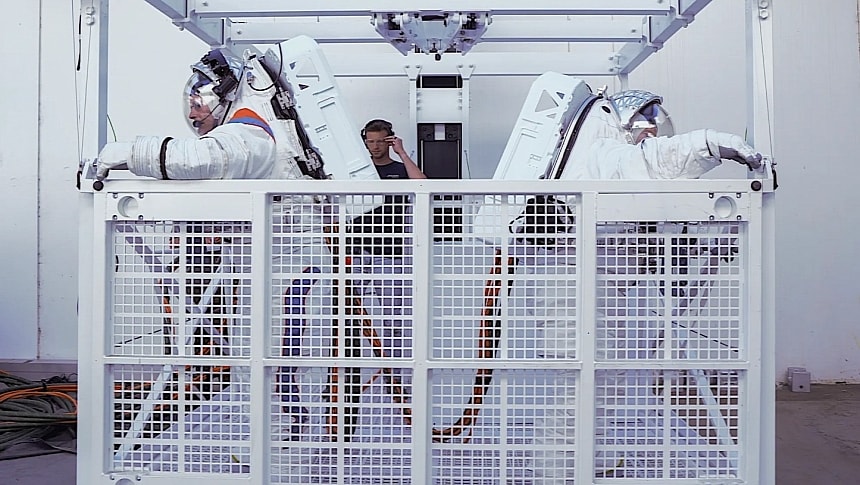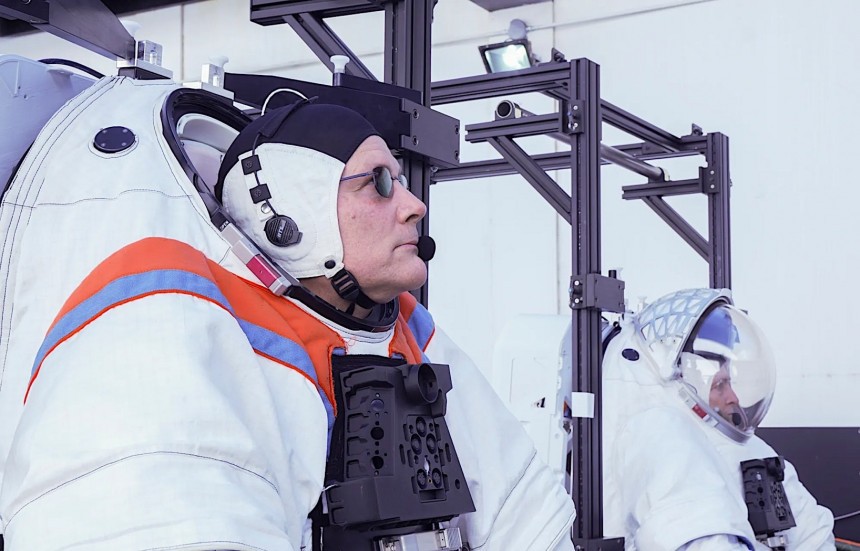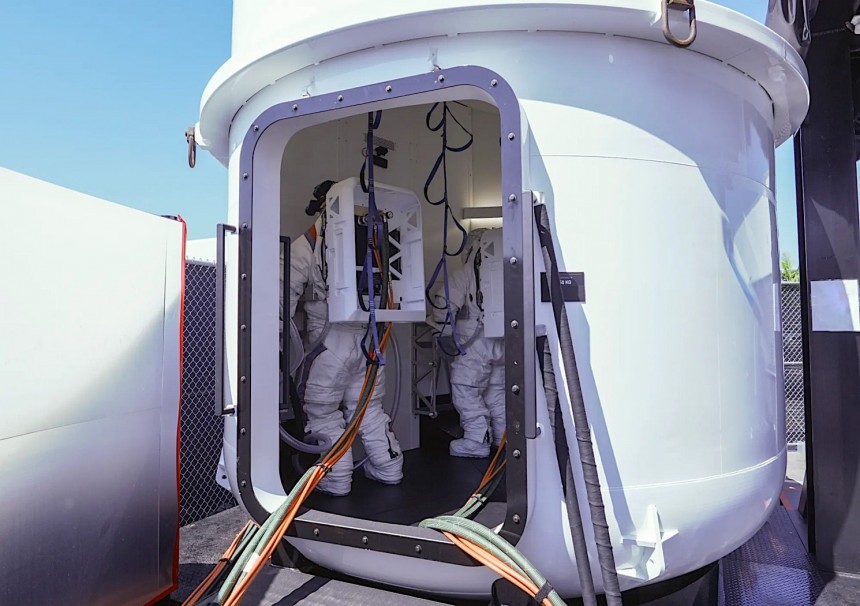It's not long now until our species will make a triumphant return to the Moon. If all goes according to plan, in 2026 human feet will indirectly touch the surface of the satellite once more, for the first time sinec 1972. And they'll do so backed not only by government agencies, but by private contractors as well.
Under the Artemis program NASA plans to launch the Artemis II crewed mission around the Moon in 2025. One year later, the first Artemis crew is scheduled to touch down on the Moon, brought down by a piece of technology developed by SpaceX: the Starship Human Landing System (HLS).
The role of the Starship is to take a pair of astronauts from the Orion spaceship in orbit to the dusty surface of the Moon. On top of that, it will become their home for about a week, and then head back into orbit to transfer them to the ship that will bring them home.
In the view of some, the HLS is probably one of the main reasons NASA had to postpone the Artemis program for more than a year (initial launch dates were 2024 and 2025 for the second and third missions, respectively). That's because SpaceX seems to be dragging its feet when it comes to developing the system.
Last time we heard anything about this version of the Starship was at the end of last year, when we were given a glimpse of the thing's elevator. That's the component that will move cargo and crew from inside the lander to the surface of the Moon.
This week we were informed of something that happened back in April, a major test of the HLS. For the first time ever, two fully suited astronauts interacted with the SpaceX design in a bid to get a better sense of what to expect.
The astronauts are NASA's Doug Wheelock and Axiom Space's Peggy Whitson, and they were both clothed in the pressurized spacesuits Axiom has been tasked with developing for the Artemis missions.
The HLS is not some finished version of the hardware that will actually be used, but a full-scale piece of developmental hardware.
For the entire day on April 30, the two astronauts were on location at the SpaceX facility in Hawthorne, California, where they worked their butts off to give NASA and other involved parties feedback on several key aspects of the HLS: layout, physical design, mechanical assemblies, and clearances.
Separately, the flexibility and agility of the suits were also under scrutiny. Called the Axiom Extravehicular Mobility Unit (AxEMU), this portable spaceship, if you will, was purpose-made to withstand the rigors of sustained activity in a hostile environment where temperatures range from minus 250 degrees Fahrenheit and up to 250 degrees (minus 156 to 121 degrees Celsius).
The scenario had the two astronauts put on their suits in the airlock of the Starship deck. Pressurization then followed, and for that a system located outside the airlock was used. The suits came equipped with the backpack that hides the life support system, in an attempt to make the test as realistic as possible.
The various procedures conducted throughout the day informed NASA about how best to place handrails and straps to help suited astronauts navigate their way while traversing the hatch.
A mock control panel was used to simulate a situation when astronauts with gloves on will have to reach and operate the lander's systems. The same gloved hands were put through their paces testing the opening of the elevator gate and lowering the ramp.
The conclusions of the procedures are simple: the SpaceX design has enough available space in the airlock, on the deck, and in the elevator for astronauts to perform their tasks.
Artemis III, the first mission that will use both the new spacesuits and lander, will carry to the Moon a crew of four, including the first woman and first person of color to ever go on a Moon mission.
The flight will depart our planet from the famous Launch Pad 39B at the Kennedy Space Center in Florida using the Space Launch System (SLS) rocket. Once in orbit, the Orion spacecraft will set course for the Moon, which it will reach some days later.
The ship will park itself in a Near-Rectilinear Halo Orbit (NRHO) that should allow it to save fuel and keep communication lines with Earth open at all times. The SpaceX lander will already be there, waiting for the Orion to arrive and hook up to it.
The Starship HLS will transfer astronauts in a region of the Moon we've never directly explored before, the South Pole. The area was chosen for the Artemis missions because of the high likelihood it may be a treasure chest filled with resources, including oxygen and water, crucial for the success of the missions to follow.
Upon return, the Orion will descend into the atmosphere and make a water landing in the Pacific Ocean, from where the U.S. Coast Guard and U.S. Navy will pick up the astronauts.
The role of the Starship is to take a pair of astronauts from the Orion spaceship in orbit to the dusty surface of the Moon. On top of that, it will become their home for about a week, and then head back into orbit to transfer them to the ship that will bring them home.
In the view of some, the HLS is probably one of the main reasons NASA had to postpone the Artemis program for more than a year (initial launch dates were 2024 and 2025 for the second and third missions, respectively). That's because SpaceX seems to be dragging its feet when it comes to developing the system.
Last time we heard anything about this version of the Starship was at the end of last year, when we were given a glimpse of the thing's elevator. That's the component that will move cargo and crew from inside the lander to the surface of the Moon.
This week we were informed of something that happened back in April, a major test of the HLS. For the first time ever, two fully suited astronauts interacted with the SpaceX design in a bid to get a better sense of what to expect.
The HLS is not some finished version of the hardware that will actually be used, but a full-scale piece of developmental hardware.
For the entire day on April 30, the two astronauts were on location at the SpaceX facility in Hawthorne, California, where they worked their butts off to give NASA and other involved parties feedback on several key aspects of the HLS: layout, physical design, mechanical assemblies, and clearances.
Separately, the flexibility and agility of the suits were also under scrutiny. Called the Axiom Extravehicular Mobility Unit (AxEMU), this portable spaceship, if you will, was purpose-made to withstand the rigors of sustained activity in a hostile environment where temperatures range from minus 250 degrees Fahrenheit and up to 250 degrees (minus 156 to 121 degrees Celsius).
The scenario had the two astronauts put on their suits in the airlock of the Starship deck. Pressurization then followed, and for that a system located outside the airlock was used. The suits came equipped with the backpack that hides the life support system, in an attempt to make the test as realistic as possible.
The various procedures conducted throughout the day informed NASA about how best to place handrails and straps to help suited astronauts navigate their way while traversing the hatch.
The conclusions of the procedures are simple: the SpaceX design has enough available space in the airlock, on the deck, and in the elevator for astronauts to perform their tasks.
Artemis III, the first mission that will use both the new spacesuits and lander, will carry to the Moon a crew of four, including the first woman and first person of color to ever go on a Moon mission.
The flight will depart our planet from the famous Launch Pad 39B at the Kennedy Space Center in Florida using the Space Launch System (SLS) rocket. Once in orbit, the Orion spacecraft will set course for the Moon, which it will reach some days later.
The ship will park itself in a Near-Rectilinear Halo Orbit (NRHO) that should allow it to save fuel and keep communication lines with Earth open at all times. The SpaceX lander will already be there, waiting for the Orion to arrive and hook up to it.
The Starship HLS will transfer astronauts in a region of the Moon we've never directly explored before, the South Pole. The area was chosen for the Artemis missions because of the high likelihood it may be a treasure chest filled with resources, including oxygen and water, crucial for the success of the missions to follow.
Upon return, the Orion will descend into the atmosphere and make a water landing in the Pacific Ocean, from where the U.S. Coast Guard and U.S. Navy will pick up the astronauts.



















